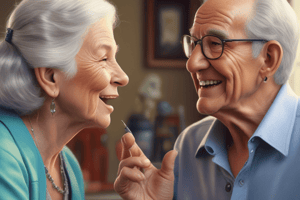Podcast
Questions and Answers
What is the purpose of padding bony prominences with soft material when applying a splint?
What is the purpose of padding bony prominences with soft material when applying a splint?
- To enhance the stability of the splint
- To prevent pressure wounds (correct)
- To reduce swelling
- To increase circulation
Why is it important to check circulation distal to an injury after splinting?
Why is it important to check circulation distal to an injury after splinting?
- To measure the range of motion in the joint
- To ensure adequate oxygen supply to the limb (correct)
- To assess the effectiveness of the splint
- To determine the need for a heavier splint
What is a primary function of traction in a medical setting?
What is a primary function of traction in a medical setting?
- To maintain alignment of bone ends and relieve pain (correct)
- To immobilize the joint completely
- To facilitate quick recovery from sprains
- To prevent any movement of the patient
Which type of traction involves the use of weights applied directly to the skeletal structure?
Which type of traction involves the use of weights applied directly to the skeletal structure?
What should be done if tissue below a splint becomes pale, cold, or blue?
What should be done if tissue below a splint becomes pale, cold, or blue?
What is an important consideration when managing the weight used in traction?
What is an important consideration when managing the weight used in traction?
Which principle is crucial for the effectiveness of traction?
Which principle is crucial for the effectiveness of traction?
What position may be ordered to prevent a patient from sliding down in bed during traction?
What position may be ordered to prevent a patient from sliding down in bed during traction?
What is the primary purpose of checking assistive devices before use?
What is the primary purpose of checking assistive devices before use?
What is the first step in using a Continuous Passive Motion (CPM) machine?
What is the first step in using a Continuous Passive Motion (CPM) machine?
Why is it important to let the CPM machine run through one complete cycle before stopping it?
Why is it important to let the CPM machine run through one complete cycle before stopping it?
What should be done to the extremity before attaching it to the CPM machine?
What should be done to the extremity before attaching it to the CPM machine?
What is the typical cycle rate setting when operating a CPM machine?
What is the typical cycle rate setting when operating a CPM machine?
How should the CPM machine be positioned on the bed?
How should the CPM machine be positioned on the bed?
What action should be taken after the CPM machine reaches full flexion?
What action should be taken after the CPM machine reaches full flexion?
What is a necessary adjustment regarding the bed while using a CPM machine?
What is a necessary adjustment regarding the bed while using a CPM machine?
What is the primary purpose of elasticized bandages?
What is the primary purpose of elasticized bandages?
Which bandaging technique is best suited for parts of the body that have a uniform circumference?
Which bandaging technique is best suited for parts of the body that have a uniform circumference?
How should the bandage be secured when performing a spiral reverse turn?
How should the bandage be secured when performing a spiral reverse turn?
What is the correct method for applying figure-of-eight turns?
What is the correct method for applying figure-of-eight turns?
When using a circular turn, what is its primary function?
When using a circular turn, what is its primary function?
What should be avoided when bandaging over a major blood vessel?
What should be avoided when bandaging over a major blood vessel?
What adjustment should be made for the spiral reverse turn technique?
What adjustment should be made for the spiral reverse turn technique?
What is a key characteristic of elastic bandages?
What is a key characteristic of elastic bandages?
What is the primary reason for washing and drying the area before applying a bandage?
What is the primary reason for washing and drying the area before applying a bandage?
Why is it recommended to elevate the extremity before applying a bandage?
Why is it recommended to elevate the extremity before applying a bandage?
What type of bandaging technique is appropriate for covering the distal parts of the body?
What type of bandaging technique is appropriate for covering the distal parts of the body?
What may older adults feel after experiencing a health event that leads to immobility?
What may older adults feel after experiencing a health event that leads to immobility?
How should the bandage be applied in terms of tension?
How should the bandage be applied in terms of tension?
Which type of splint is specifically designed to help control bleeding?
Which type of splint is specifically designed to help control bleeding?
What is a crucial step to take after applying a bandage to ensure proper fit?
What is a crucial step to take after applying a bandage to ensure proper fit?
What is the primary purpose of a splint?
What is the primary purpose of a splint?
What is a key consideration when applying a splint to an extremity?
What is a key consideration when applying a splint to an extremity?
Why should metal clips not be used to secure the end of a bandage?
Why should metal clips not be used to secure the end of a bandage?
What is the purpose of making two initial circular turns when anchoring a bandage?
What is the purpose of making two initial circular turns when anchoring a bandage?
Which of the following splints is used for chronic disorders to maintain functional ability?
Which of the following splints is used for chronic disorders to maintain functional ability?
What should be done after covering the area with a recurrent turn bandage?
What should be done after covering the area with a recurrent turn bandage?
What should be covered on any open wounds before applying a splint?
What should be covered on any open wounds before applying a splint?
What materials can be used to create a makeshift splint?
What materials can be used to create a makeshift splint?
Which of the following statements is true about immobilizers?
Which of the following statements is true about immobilizers?
Flashcards are hidden until you start studying
Study Notes
Older Adult Considerations
- Older adults may experience depression and feel like a burden post-incident (e.g., stroke, hip fracture).
- Encouragement, kindness, and family support are vital to restoring their self-worth.
- Consulting social services can provide financial assistance and additional resources.
Types of Immobilization
Splints
- Splints immobilize an injured body part, serving as first aid before a cast or traction.
- Types of splints include:
- Molded splints: Maintain functional position to prevent contracture.
- Immobilizers: Cloth and foam with Velcro, commonly used on knees.
- Inflatable splints: Control bleeding while immobilizing; inflate to 1.5 inches of fingertip indentation.
- Cervical collars: Support neck injuries.
- Traction splints: Used for fractures, requiring traction ropes and weights.
Application of a Splint
- Handle the injured area gently to reduce nerve injury and bleeding.
- Cover wounds with clean material to prevent infection.
- Use rigid materials such as flat boards or broom handles to immobilize the injury.
- Ensure splint extends above and below the injury.
- Pad bony areas to prevent pressure sores.
- Secure the splint firmly and elevate injured parts to reduce swelling.
Traction
- Traction uses pulling forces to maintain body parts in extension and alignment; aids realignment and pain relief.
- Types of traction include:
- Manual: Physical pulling by caregivers.
- Skin: Adhesive traction via skin.
- Skeletal: Weights applied directly to bones.
- Initial heavier weights may be needed to overcome muscle tension, reducing over time as muscles relax.
- The bed should be raised no more than 20 degrees to prevent slippage.
Principles of Traction
- Ensure ropes and weights are free of friction and entanglements.
- Continuous traction is necessary as ordered; do not interrupt during care.
- Evaluate assistive devices for structural integrity and proper function.
- Assess the patient’s ability to use assistive devices safely.
Continuous Passive Motion (CPM) Machine
- Commonly employed after knee surgery; requires careful setup per surgeon's order.
- Steps for use include:
- Checking order limits for flexion/extension and speed.
- Connecting and centering the machine appropriately on the bed.
- Ensuring the dressing is intact before use to prevent injury.
- Observing function during operation and adjusting as necessary.
Elastic Bandage Application
- Used for immobilization, pressure application, and wound support.
- Different bandaging techniques vary based on body part, including:
- Circular turn: Anchors bandage, suitable for fingers/wrists.
- Spiral turn: For uniform parts like arms or legs.
- Figure-of-eight turn: Stabilizes joints like elbows or knees.
- Recurrent turn: Covers distal parts; used for stumps or fingers.
Bandaging Technique
- Wash and dry the area before applying a bandage to prevent infections.
- Elevate the extremity to promote venous return and reduce swelling.
- Secure the bandage with circular turns to prevent loosening.
- Ensure even application with light to moderate tension to avoid pressure points.
- Check fit and circulation regularly to prevent complications from tight bandaging.
Studying That Suits You
Use AI to generate personalized quizzes and flashcards to suit your learning preferences.




